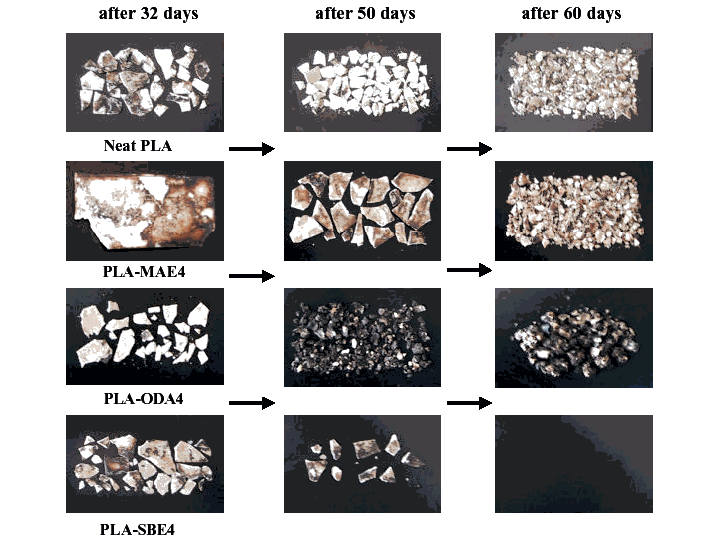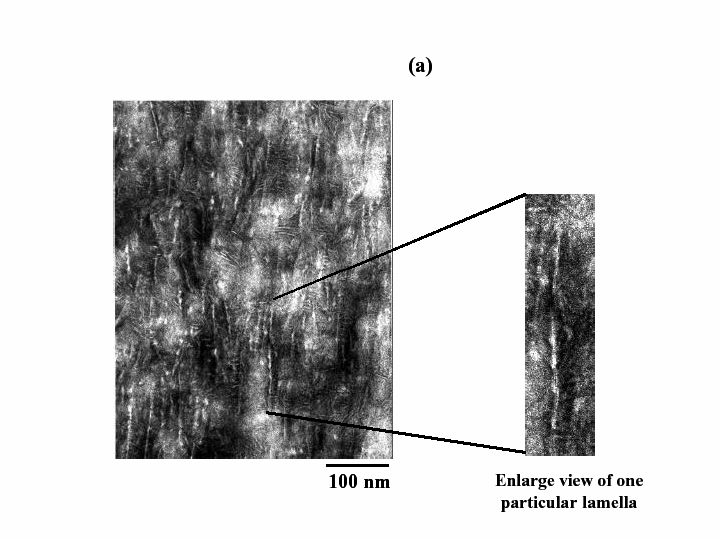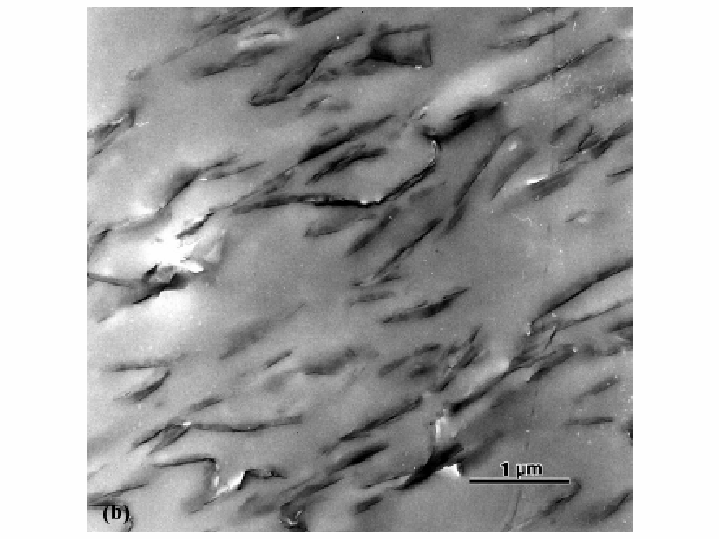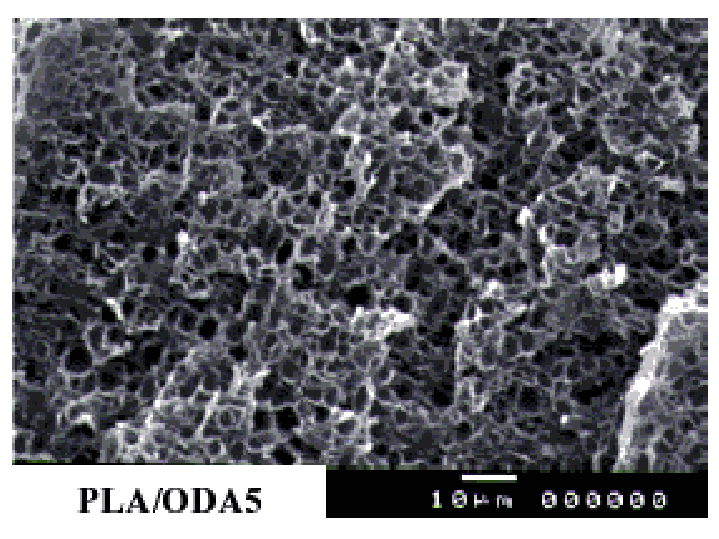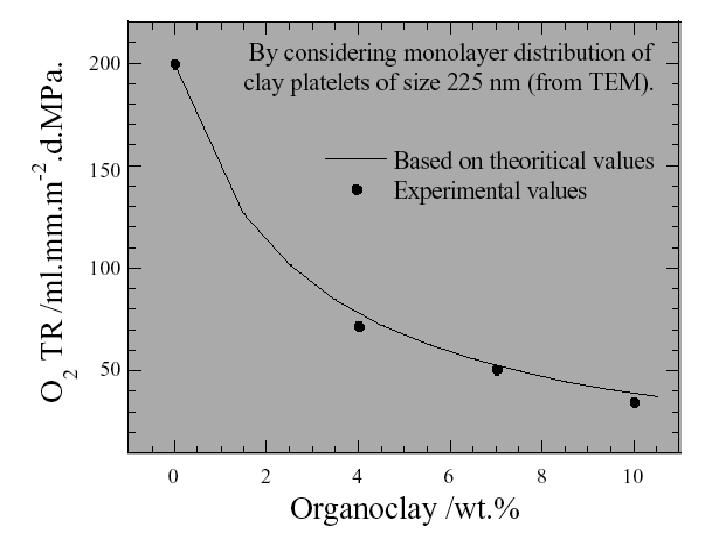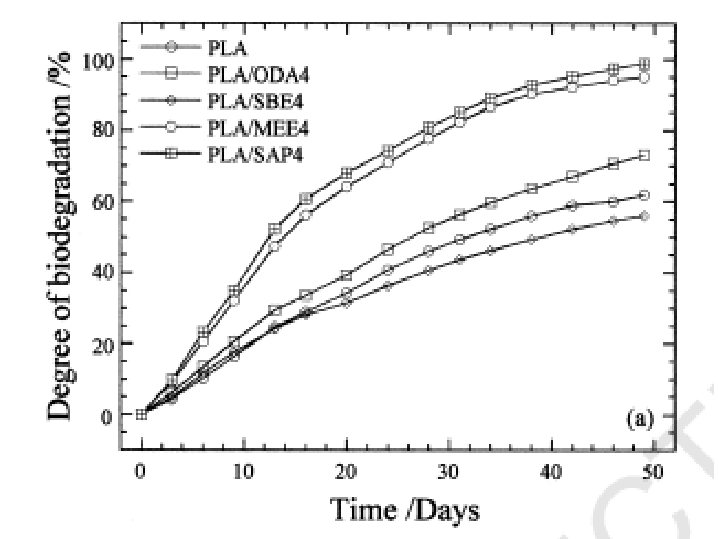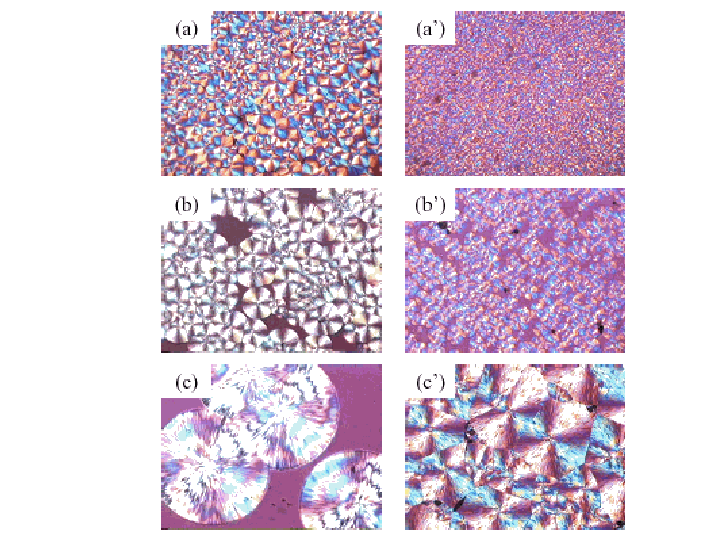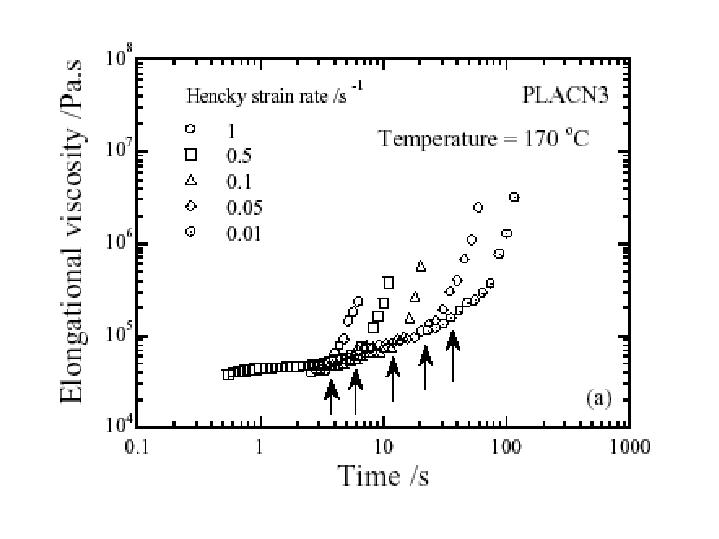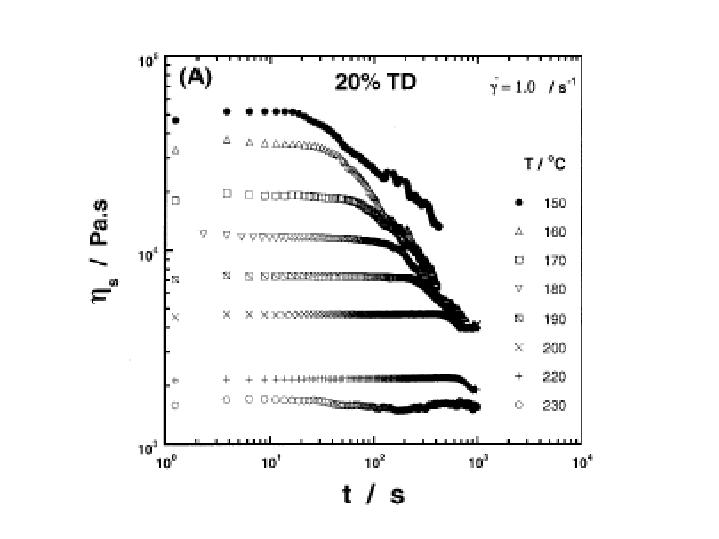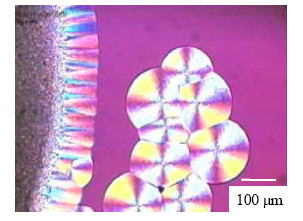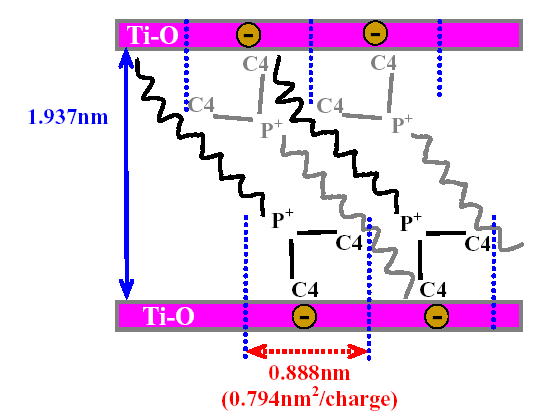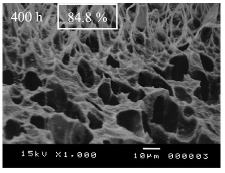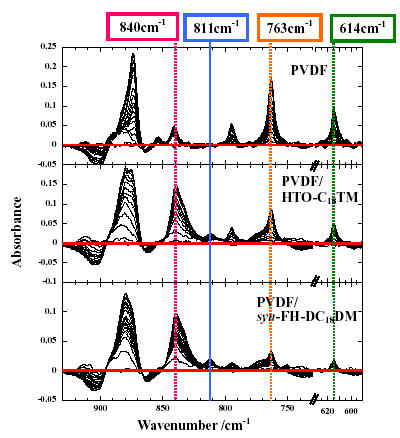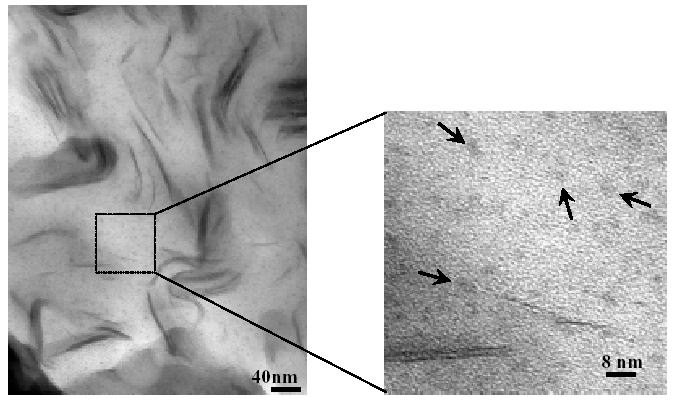 |
The highly neutralized ionomer-based nano-composite materials were prepared
via direct melt processing using zinc oxide (as a neutralizating agent)
and organically modified clay. The nano-structure was characterized using
wide-angle X-ray diffraction analyses, transmission electron microscopy
observations and rheometry. The dispersed organo-clay acted as catalytic
sites for the neutralization. From TEM analyses, the nano-sized ionic aggregates
with a domain size of approximately 2 nm were randomly arranged in the
ionomer matrix. The calculated aggregates density for the nano-composite
was 0.08-0.15 nm-2.
The temperature-dependent relaxation process observed in the viscoelastic
measurements was somehow affected by the presence of the silicate layers,
whereas it was strongly affected by the specific interaction via ionic
aggregated domains.
Composite Part A, 2008, 39, 1924-1929 |
 |
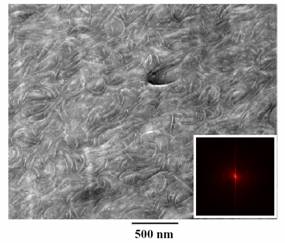 |
To
understand the effect of the montmorillonite
(MMT) particles on the
crystallization kinetics and crystalline morphology of nylon 6 upon nano-composite formation, we have characterized the crystallization behaviors by
using light scattering, wide-angle X-ray diffraction (WAXD), transmission
electron microscope (TEM) and rheological measurement. The
correlation between the nucleating effect and the growth mechanism of the
different polymorphism (g-phase) of nylon 6 in the nano-composite
(N6C3.7) was probed. N6C3.7 exhibited g-phase
crystal due to the nucleating effect of the dispersed MMT particles into the
nylon 6 matrix throughout the whole Tc
range (= 150-215 °C). The lamellar growth of the g-phase
crystal took place on both sides of the dispersed MMT particles. In comparison
between the temperature dependence of the characteristic relaxation time and
the crystallization time, the lamellar growth of the g-phase crystal has been discussed. The stable growth
of the g-phase was strongly disturbed at at low Tc range (= 160-190 °C) due
to the lack of time for crystallization.
Polymer,2009, 50, 4718-4726
|
 |
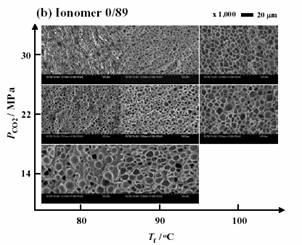 |
Via a batch process, the foam processing of polyethylene-based
ionomers having two different degree of the neutralization has been conducted
using supercritical CO2. The cellular structures obtained from
various ranges of foaming temperature-CO2 pressure were investigated
by using field emission scanning electron microscopy. For comparison, the
corresponding nano-composite also has been examined. The ionic cross-linked
structure in the ionomer exhibited significant contribution to retard the cell
growth and coalescence of cell, especially in ionomer having higher degree of
the neutralization. For nano-composite foaming, experimentally, nano-clay
particles led to an increase in cell density after foaming. However, the
dispersed nano-clay particles did not act as nucleating sites for cell
formation. The competitive phenomenon between the cell nucleation and the cell
growth including the coalescence of cell was discussed in the light of the
interfacial energy and the relaxation rate as revealed by the modified
classical nucleation theory and rheological measurement, respectively.
Composites: Part A, 2009, 40, 1708-1716
|
 |
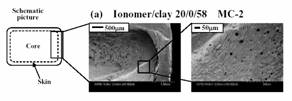 |
To understand the correlation between
foamability and melt rheology of polyethylene-based ionomers having different
degree of the neutralization and corresponding nano-composites, we have
conducted the foam processing via a batch process in an autoclave and
microcellular foam injection molding (FIM) process using the MuCell(R) technology. We have discussed the obtainable morphological properties in both foaming processes. All cellular structures were investigated by using field emission scanning electron microscopy. The competitive phenomenon between the cell nucleation and the cell growth including the coalescence of cell was discussed in the light of the interfacial energy and the relaxation rate as revealed by the modified classical nucleation theory and rheological measurement, respectively. The FIM process led to the opposite behavior in the cell growth and coalescence of cell as compared with that of the batch process, where the ionic cross-linked structure has significant contribution to retard the cell growth and coalescence of cell. The mechanical properties of the structural foams obtained by FIM process were discussed.
Mater. Sci. Eng. C, 2010, 30, 62-70
|
 |
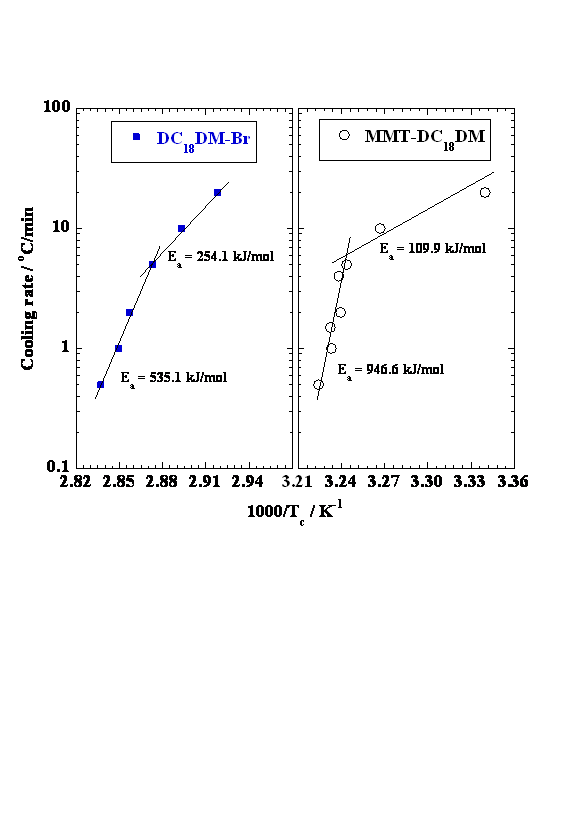 |
To
understand the effect of
confined space (interlayer space in montmorillonite (MMT)) on the nonisothermal
ordering transition
(chain packing) kinetics and disorder
transition (chain melting) behavior including the conformational changes of the chain segment of
the cationic surfactants, we have characterized MMT modified with dioctadecyl dimethylammonium
(DC18DM) ions (MMT-DC18DM) using temperature-modulated differential
scanning calorimeter (TMDSC), wide-angle X-ray diffraction (WAXD) and Fourier
transform infrared spectroscopy (FTIR) technique. For MMT-DC18DM,
the chain conformational disorder-order phase transition took place during the cooling
process. The transition peak was much broader and it appeared at lower
temperature (Tc) when
compared to the crystallized dioctadecyl dimethylammonium bromide (DC18DM-Br),
as a reference
In MMT-DC18DM, the
formation of gauche conformers was enhanced and the chains were not as densely
packed as in crystalline DC18DM-Br. The normal crystallization took
place in the bulk during the nonisothermal crystallization of DC18DM-Br.
The confined ions (DC18DMs) in one or two dimensional order
contributed to the nonisothermal chain packing for a higher cooling rate of
5.0-20.0 °C/min. The observed chain packing in confined space at different Tc ranges (cooling rate >
5.0 °C/min) could be explained by much lower energy barrier.
Appl. Clay Sci., 2010, 48, 73-80
|
 |
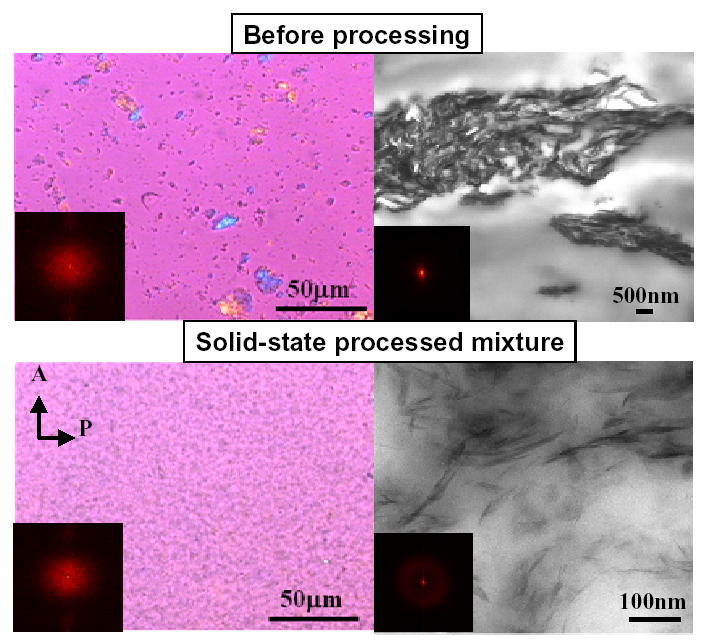 |
Solid-state processing for the preparation of polypropylene (PP)-based
nano-composites having finely dispersed layered fillers was conducted.
The mixture of PP and organically modified layered filler (OMLF) (95:5
wt./wt.) was subjected to the processing using alumina mortar heated 65
°C, below Tm of PP (i.e., PP is still at the solid-state), and ground
for 8 h before melt compounding. On X-ray diffraction, the d(001) peak
of OMLF was broaden and peak position shifted slightly. The mixture prepared
by solid-state processing exhibited disorder and delaminated layer structure
with the thickness of 3-7 nm into PP matrix through TEM observations. On
the contrary, nano-composite prepared by melt compounding at 180 °C for
3 min (without solid-state processing) showed the large stacked silicate
layers in the PP matrix. Furthermore, instead of using alumina mortar,
we carried out solid-state processing using internal mixer. X-ray diffraction
pattern and TEM observation exhibited similar results. The solid-state
processing led to delaminate of the silicate layers and attained the discrete
dispersion.
Polymer, 2010, 51,4238-4242
|
 |
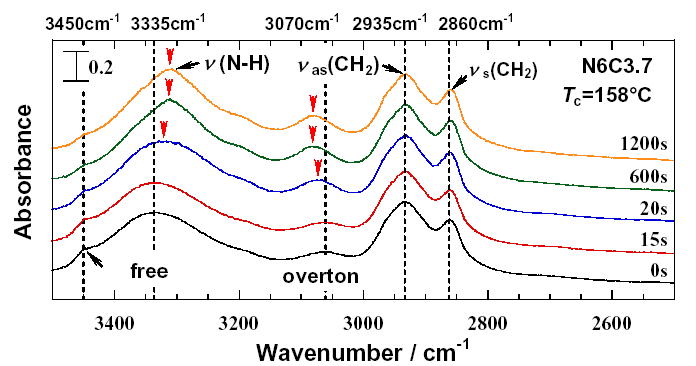 |
Via time-resolved FTIR, we examined the real-time investigation of the
structural change in molecular chain of nylon 6 during crystallization
of neat nylon 6 and the corresponding nano-composite (N6C3.7) having fully
exfoliated structure. The neat nylon 6 predominantly formed alpha-phase
in the crystallization temperature (Tc) range of 155-195 °C. For N6C3.7
crystallization at low Tc range of 150-168 °C, where the network structure
formed by the dispersed clay particles still affected chain folding of
nylon 6, the formation of the gamma-phase was dominant. The crystallization
took place so rapidly (less than 1s) without induction time of crystallization.
At high Tc range (=177-191 °C), the stable growth of the alpha-phase crystal
coexisting with gamma-phase occurred in N6C3.7 crystallization. The growth
mechanism in the subsequent crystallization processes (amides III alpha
and III gamma) were virtually the same in both N6C3.7 and neat nylon 6.
Polymer, 2010, 51,5585-5591 |
 |
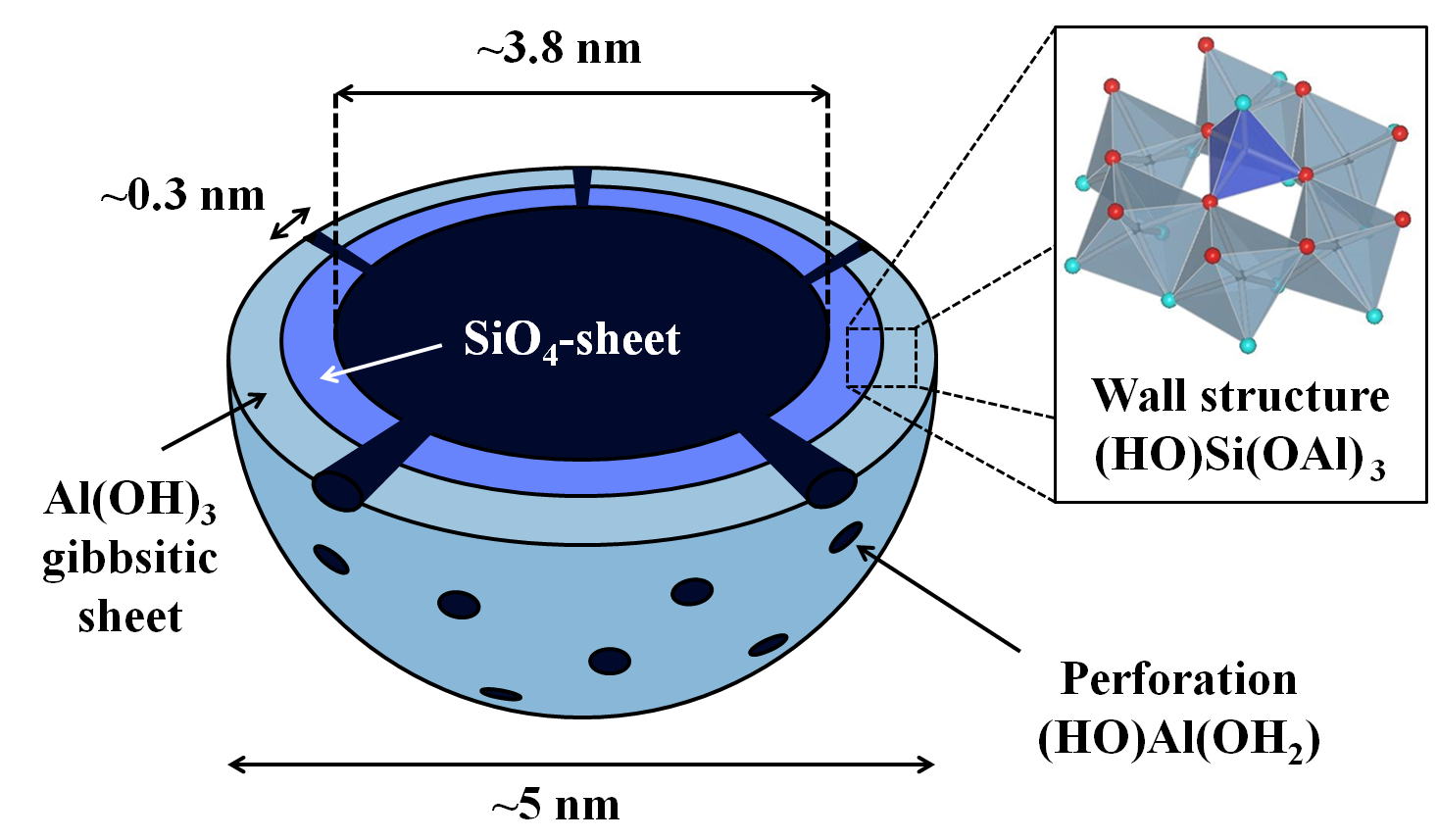 |
We synthesized three allophanes from precursors by a hydrothermal reaction at 100°C for 48h. The precursors were formed from the solutions of Na4SiO4 and AlCl3?6H2O at different Si/Al molar ratios (0.5, 0.75, 1.0). The nanostructure of the synthetic allophanes was compared with that of a natural allophane from New Zealand by using X-ray diffractometry, energy dispersive X-ray spectroscopy, Fourier-transform infrared spectroscopy, thermogravimetry/ differential thermal analysis, 29Si and 27Al magic angle spinning (MAS) nuclear magnetic resonance (NMR), field emission electron microscopy, and pore-size distribution based on the Cranston-Inkley method. The propensity of the allophanes to adsorb adenine and adenosine-5’-monophosphate (5’-AMP) was assessed by batch experiments. The adsorption data were fitted by the Freundlich equation and the adsorption parameters were discussed in relation to the properties of the natural and synthetic allophanes. The adsorption capacity (Kf) of the natural allophane for 5’-AMP was three times that for adenine. The average Kf value of the three synthetic allophanes for 5’-AMP was more than twice that of the natural allophane, possibly due to the higher purity of the synthetic allophanes.
Key words: allophanes, nanoparticles, adenine, 5’-AMP, adsorption.
Appl. Clay Sci., in press, 2011
|
